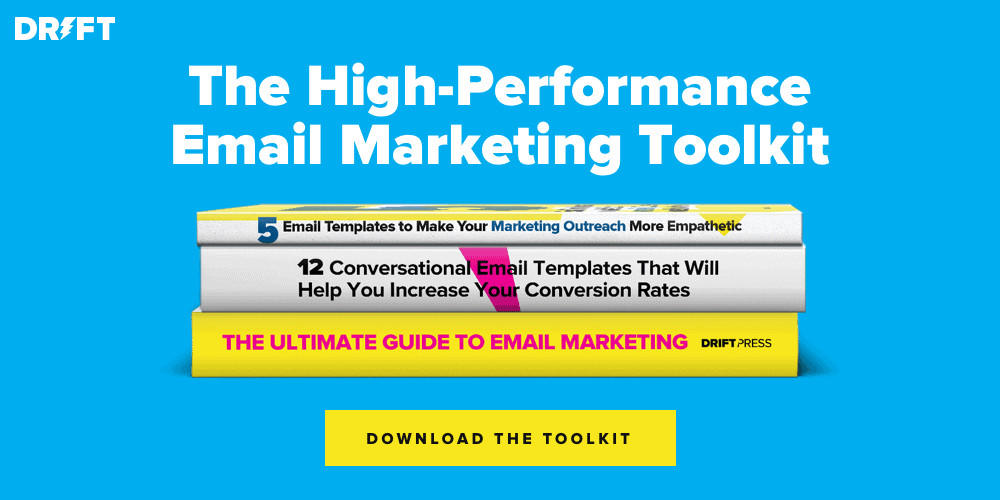
It’s no secret 2020 transformed the job market. More people are working from home. More companies are hiring remote workers. And more email addresses are changing with those new jobs.
In March alone, we saw an 18% increase in bounce rate, changed jobs, and “so-and-so has left the company” email replies. If you’re anything like me, your demand gen-obsessed mind is thinking about one thing: email database management.
Maintaining an email marketing database is one of the most vital parts of a demand marketer’s job. It’s how they reach out to the right audiences, curate contact preferences, and keep track of potential future customers. And most importantly, a healthy database helps marketers improve campaign performance and generate revenue for their company.
Yet even though these databases hold so much power, 71% of marketers admit to struggling to keep up with out-of-date systems.
And I get it. It’s a lot of work to keep a database up-to-date. But when you weigh the risk and reward, I think you really start to see not just the value of maintaining a healthy database, but the urgency, too.
Here are the big numbers that motivate me and my team on a daily basis:
- 31.6 billion emails are sent by marketers each year
- $42 (up from $38 in 2018) for each $1 spent is the average email ROI
- There’s a 22.5% decay in email marketing databases each year
As you can see, there’s a lot on the line. My advice? Don’t let your database become a black hole where contacts go to die.
Database maintenance is something that you can tackle NOW that will have a measurable impact on the business. That’s why I’m sharing learnings from my recent conversation with ZoomInfo’s VP of Marketing, DeAnn Poe. You’ll learn about the importance of healthy email marketing databases, what actions marketers can take to keep their inbox deliverability on the up and up, and how to turn things around when they fall by the wayside.
Your Database Health = Your Campaign Performance
When done well, email marketing is great for customer engagement and boosting your company’s bottom line. However, successful email marketing depends on several factors. Without everything in its place, something will come loose – and your campaign performance will suffer because of it.
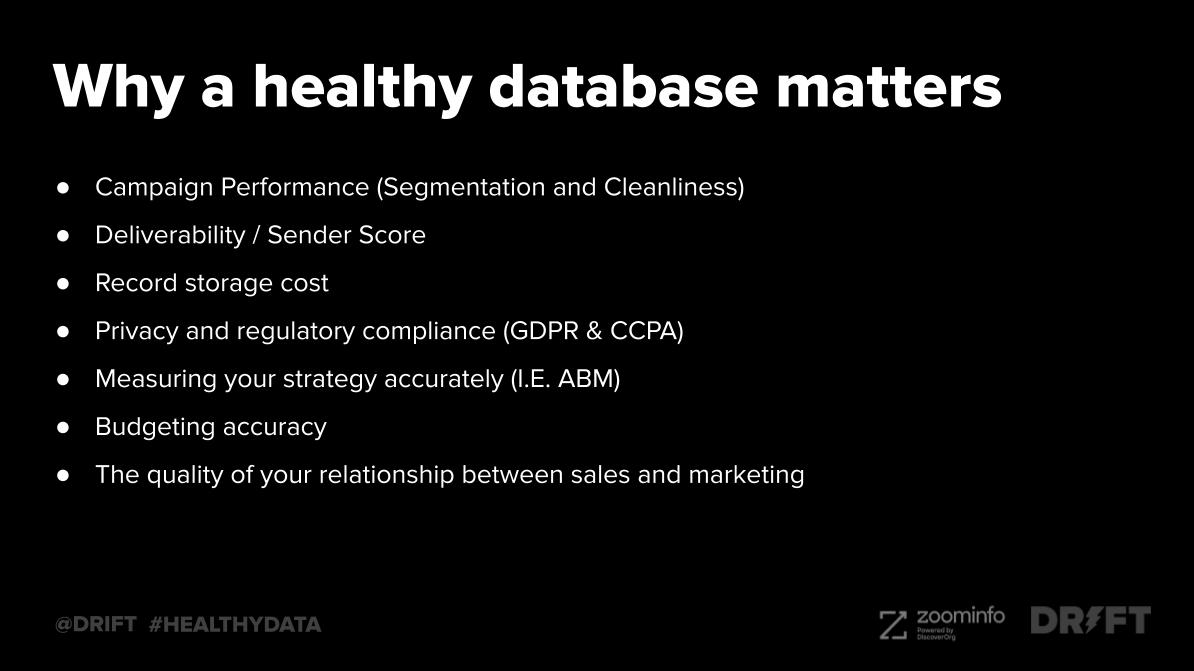
This is why it’s important to have a strong foundation to build upon and a healthy email marketing database is the number one place to start.
Bad Data’s Harsh Impact
What happens when bad data is allowed to sit and marinate for a long period of time? Nothing good, I can tell you that much. But here are some hard and fast numbers 👇
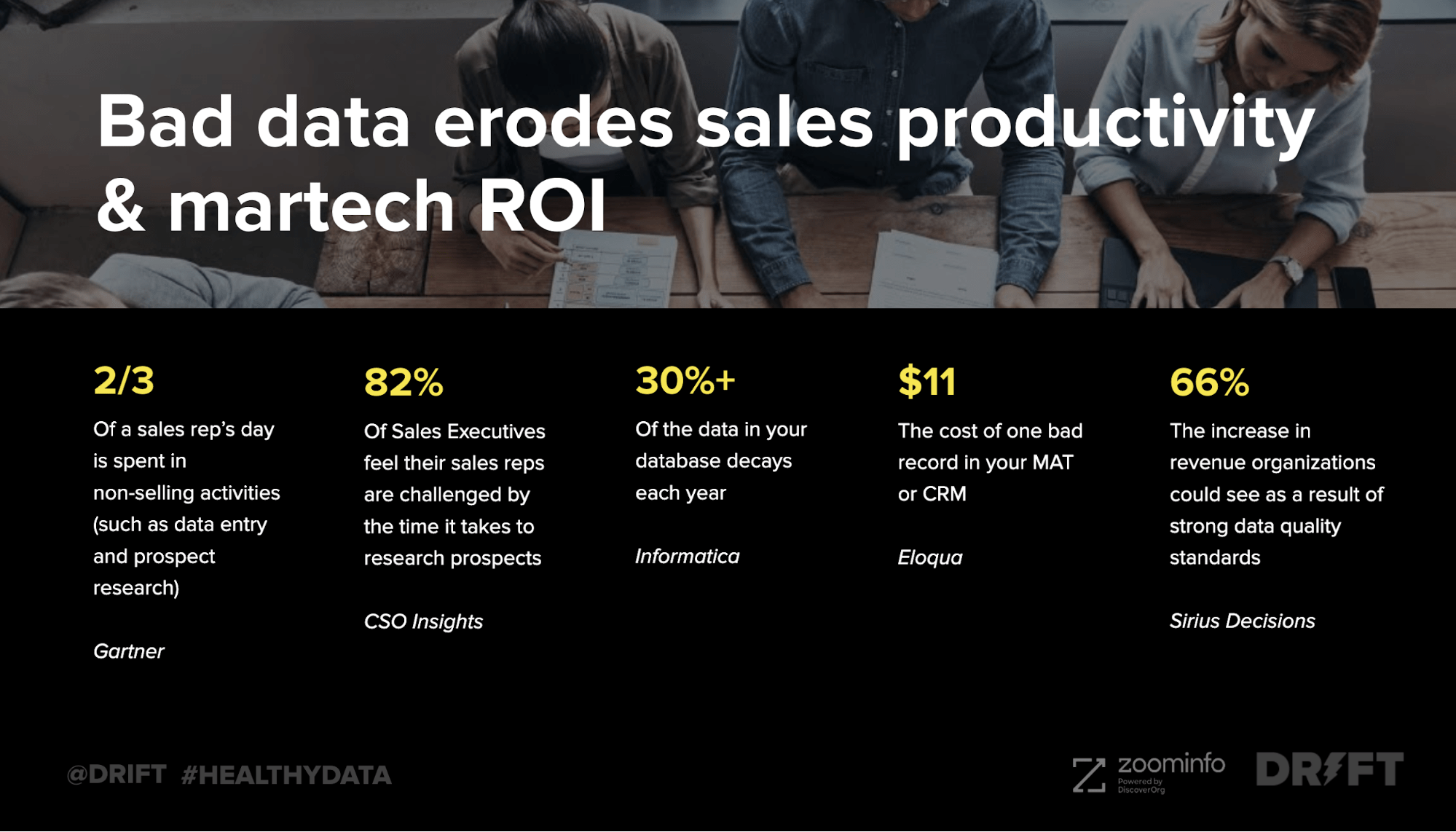
What stands out to me is the loss of potential revenue just because your database hasn’t been updated. If we simply keep our databases up-to-date, that’s a 66% increase in the sales pipeline.
There are many things outside our realm of control as marketers and sales professionals (? , COVID). Databases, as monotonous as they are to upkeep, are one of the most basic ways we can control future revenue streams.
Before you can begin to get to the root of what’s going on with your database maintenance, you need to do a thorough analysis of where everything stands.
The Segmentation Category Breakdown
Segmentation, segmentation, segmentation. I cannot stress this enough. Without bucketing your database into specific areas, your database will not reach its full ROI potential.
There are many ways to segment your database. We’ve found The Good, The Bad, and The Unknown are good jumping-off points for defining segmentation categories.
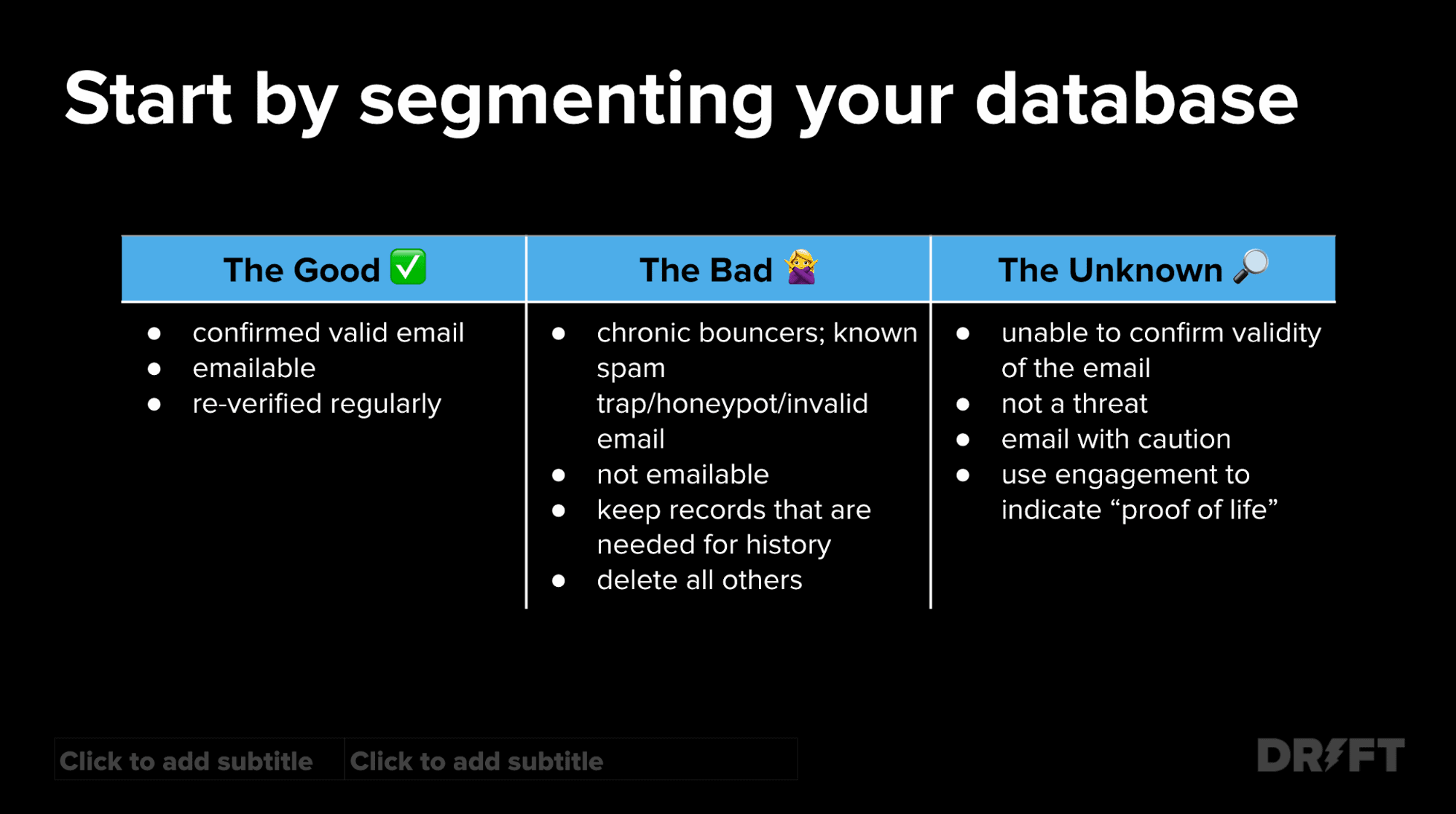
After setting these up, your team can add on their own custom categories for more targeted customer details and campaign personalization.
Although the three categories I’ve just listed are where we recommend starting, DeAnn said something that you’ll also want to consider: “The unfortunate thing is that most of your database is probably going to fall into The Unknown category. It’s not going to be as cut and dry. It’s going to be very neutral. It doesn’t mean ‘good’ or’ bad.’ It just means that with validation tools that exist today that they’re unable to get a clear answer around whether or not that email is valid, so email with caution for this group.”
The Bad: Landing in the Inbox
We already know what to do with The Good contacts. But what about The Bad and The Unknown? Let me break down how to strategically tackle both groups.
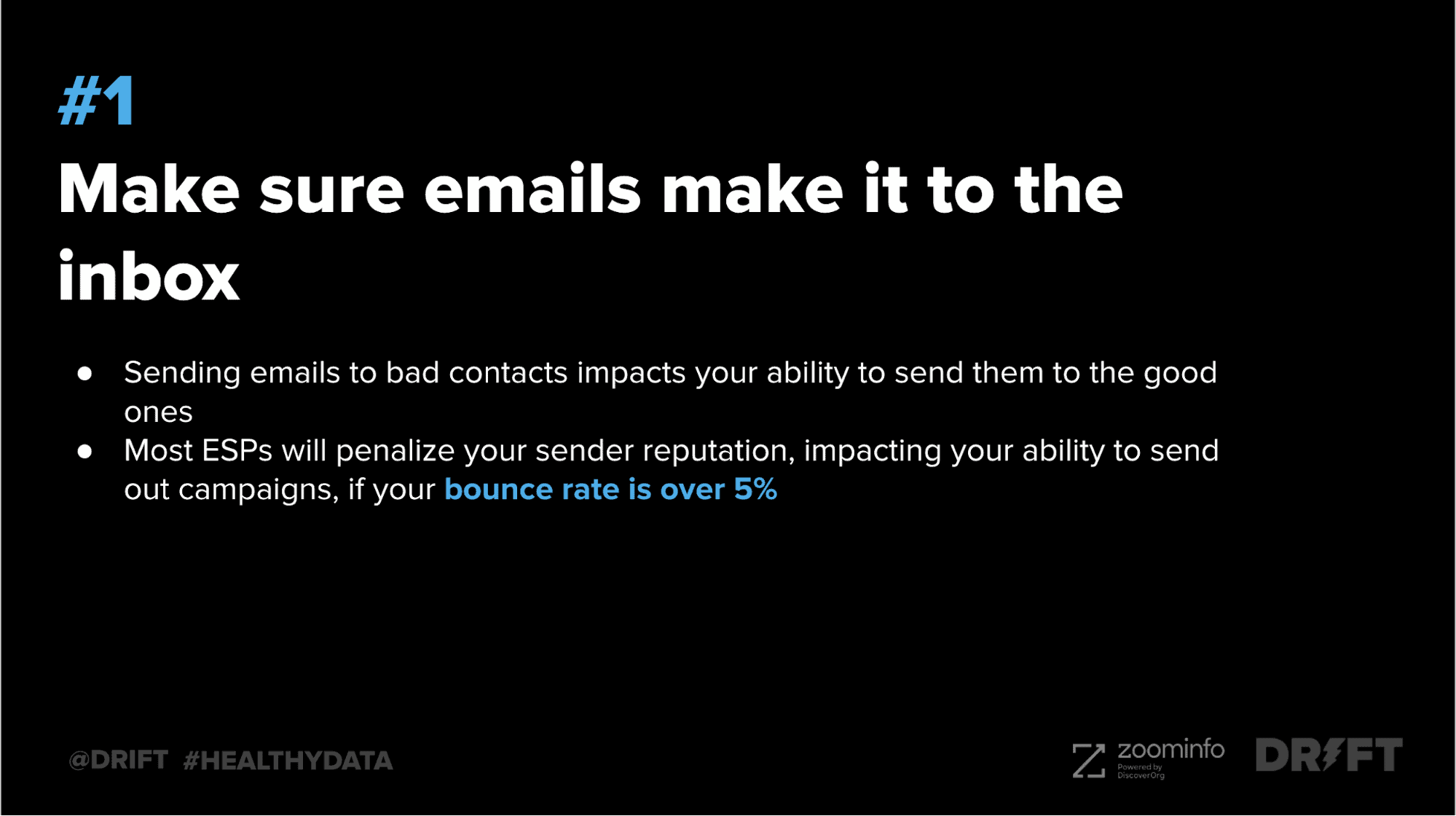
Believe it or not, email service providers are keeping an eye out on your campaigns. Every campaign email sent out is tracked which is done to help avoid spammers. If you get caught spamming people’s email, your email service provider will shut you down. This is yet another reason why it’s important to ensure your database is regularly updated.
If you’re sending out too many campaigns in a short period of time, you could be considered spam and blacklisted. DeAnn and I were talking about one of the most obvious parts of email marketing campaigns – landing in the inbox itself.
Here’s what DeAnn shared with me: “We should not be sending emails to The Bad because continuing to do so is actually impacting our ability to get in front of the good ones. It makes sense once you kind of talk through it, but it’s not something that’s very intuitive. It’s just one of those things where, ‘Oh, I just keep sending and the bad ones will bounce and The Good ones will get through.’ That kind of thinking will actually put you in a really bad place, because you’re hurting your company’s reputation in the long run.”
Campaigns are not going to perform if you can’t get into the inbox itself.
Marketing automation software can detect when your team keeps sending out emails or ones that don’t have a positive interaction. If this is the case for your efforts, your platform can actually shut your account down for a period of time.
If your marketing automation software or email service provider shuts you down, you can’t email anyone. And if you can’t send out emails, just think about the amount of lost revenue and sales opportunities ?
I’ve known marketers who’ve been blacklisted by marketing automation platforms and it took years to rebuild their reputation score. Yes, years. Don’t let that happen to you.
The Bad: Personalization + Relevancy = Win Win
“Hello (insert name here)”
It’s happened to all of us. You open an email only to see whoever did the outreach didn’t bother to learn your name before hitting send.
There’s nothing worse than opening an email addressed to the wrong person or no name at all. With more than 293 billion business and consumer emails sent daily, there’s a lot of room for error. And that figure is expected to continue growth to 347 billion by 2023. It’s one of the highest performing ROI of all marketing channels. So why leave that large piece of the marketing pie to chance by not simply personalizing the outreach?
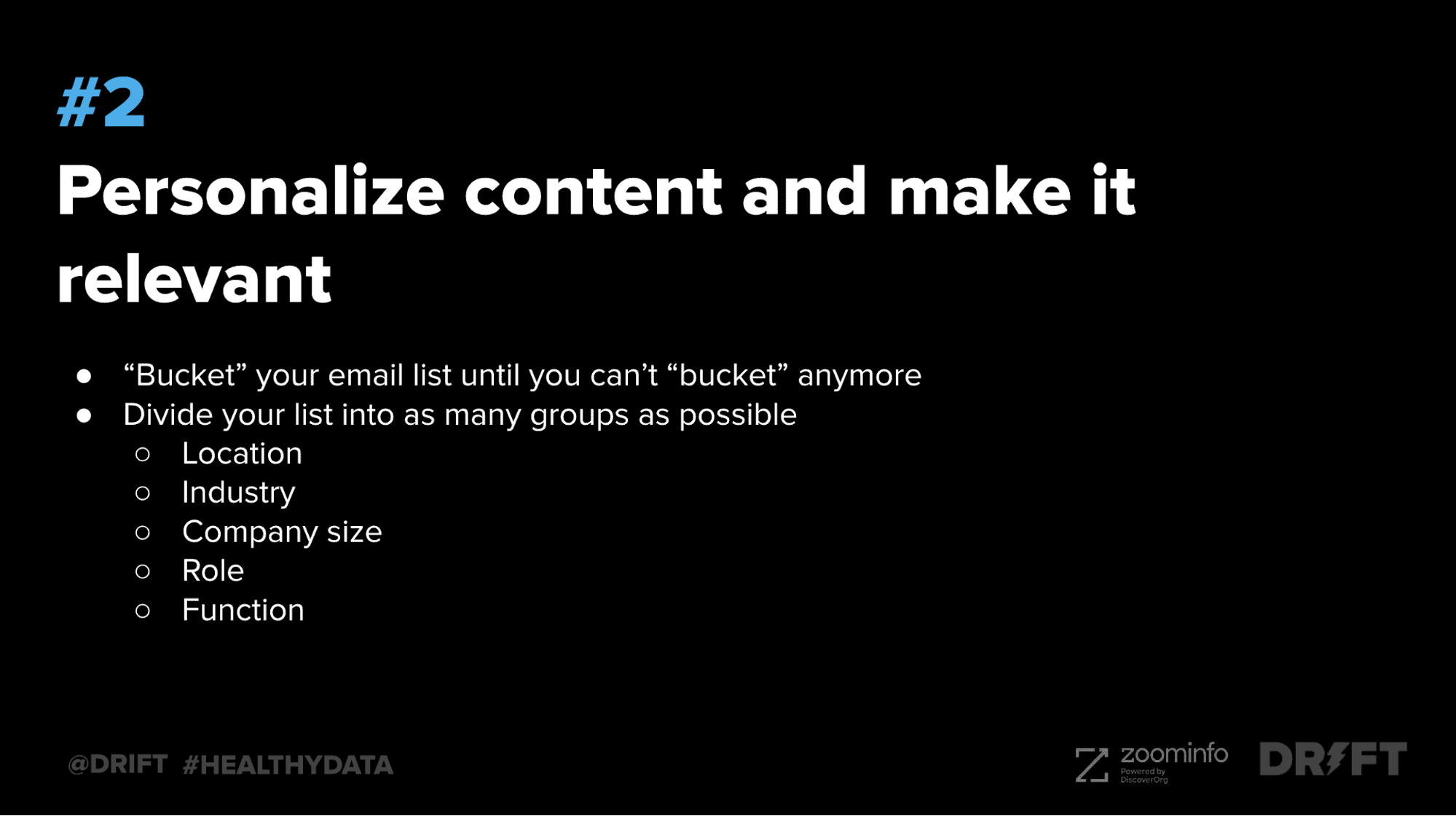
Everybody wants to feel like the content they’re receiving is just for them. When a company takes the time to learn a fraction of information about their customers, customer engagement ROI is almost always a guarantee.
DeAnn really drove the personalization point home when she shared the benefits of bucketing email lists into smaller and smaller groups: “Depending on your target market, location, industry, role function, and other pertinent areas, you’re going to divide your database into segments which allows you to personalize at scale. Don’t create 10 different tracks for every single one, but make it personalized enough that it feels really relevant to the recipient which helps with your response and deliverability.”
And when I say personalization, I don’t mean drop-in, first name, token, and call it a day. Go above and beyond that to show your customers you really care.
The Bad: Automate Wherever Possible
Email automation is key when you want to remove contacts that bounce back, are not responsive, or just aren’t engaging with your content. If you’ve got a great AI tool that recognizes autoresponder “out of office” or “this person is no longer with the company” emails, they’ll be flagged for your business development team to update.
Below is a screenshot of the Drift Email platform which shows our campaigns and how we were able to update over 5,000 contacts. Now, imagine having one or two people pouring through every email to find and update those – it would take days.
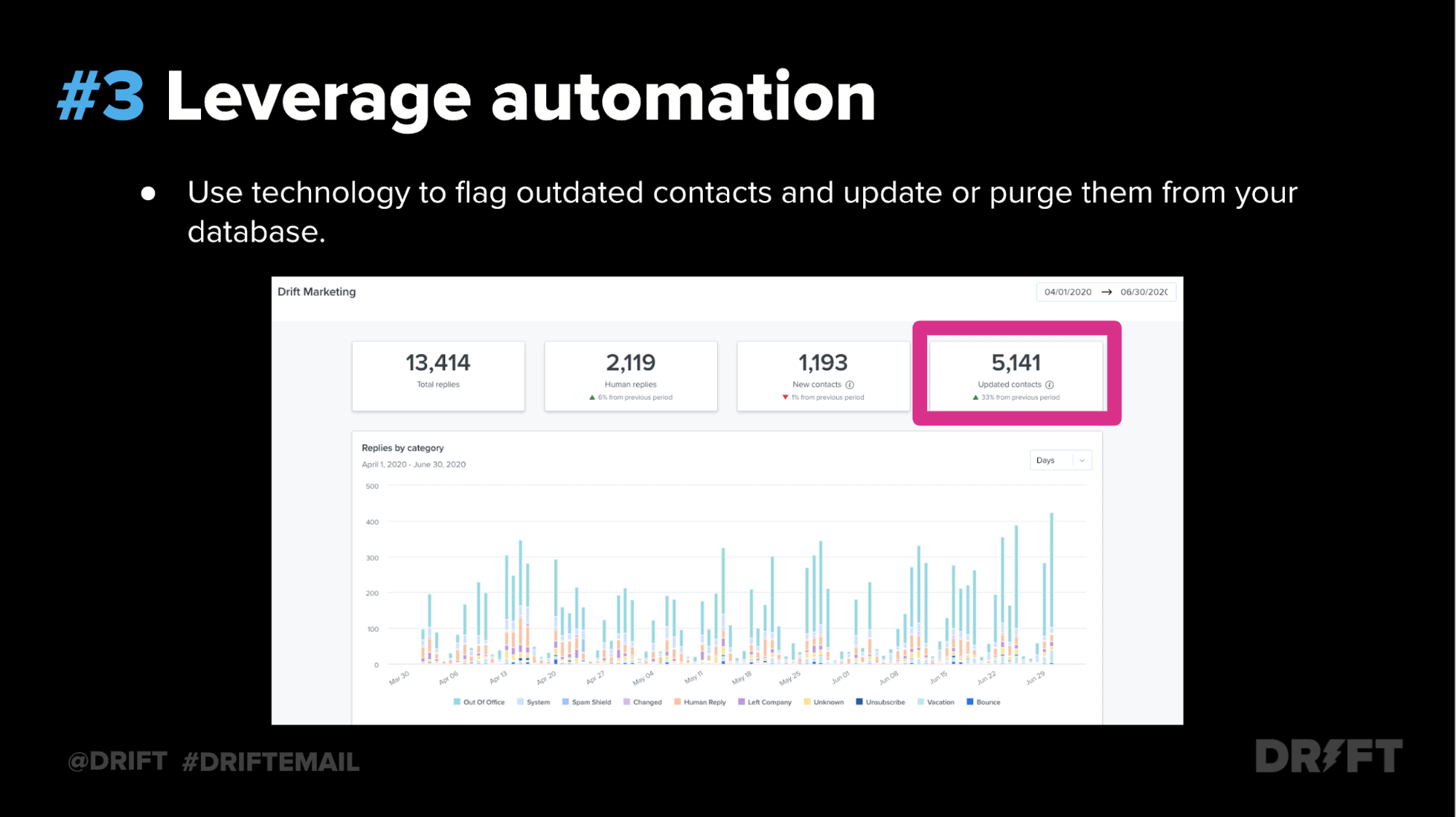
Technology is there to help us with the menial and mundane tasks. DeAnn said it best: “There’s nothing sexy about database hygiene. It’s one of those things that if you can leverage technology to do this in the background, you can feel confident about the campaigns you’re putting forward. It’s all happening without you even having to think about it and that’s even better.”
The Unknown: Filter It Out
If you’ve done everything possible to figure out whether an email is legitimate but still haven’t reached a definitive conclusion, it falls in The Unknown zone.
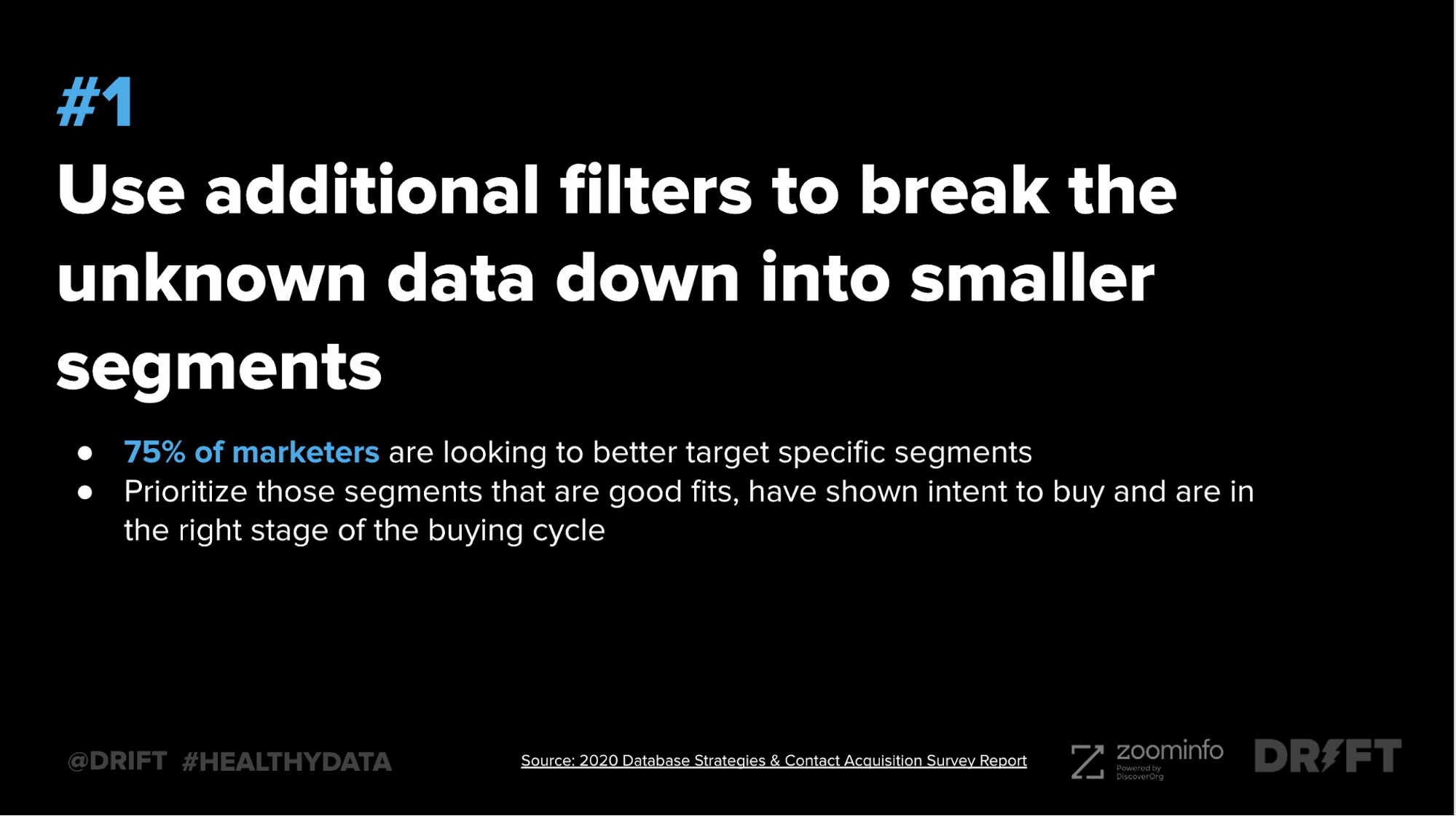
To help combat The Unknowns, set up filters to help further break down those tough prospects. It’s also a good idea to do A/B testing for email formats. Try sending out your campaigns from different automation platforms. There are a number of ways you can mix things up to see if there’s an actual person on the other end of The Unknown email.
Perhaps the most intriguing part of these unknown emails is just that – we have no idea how that person will react (if at all). DeAnn shed a bit of light here by adding in even more filters to refine marketers’ efforts for this group: “After breaking down the unknowns as far down as you can, the other piece of this is adding in some potential behavioral elements. Have they been visiting your website? Would you have any third-party intent data that you’re feeding in to see? Again, you want proof there’s a live person at the other end of that email address, but also further proof that they’re interested and ready to buy (or at least have a conversation with you).”
The Unknown: Inactive vs. Active
There may be a few Unknowns that are visiting your site but they’re just not interacting with your email campaigns.
The fix? Use the pages they visit and places where the website heatmap shows they’re lingering to better tailor your messages.
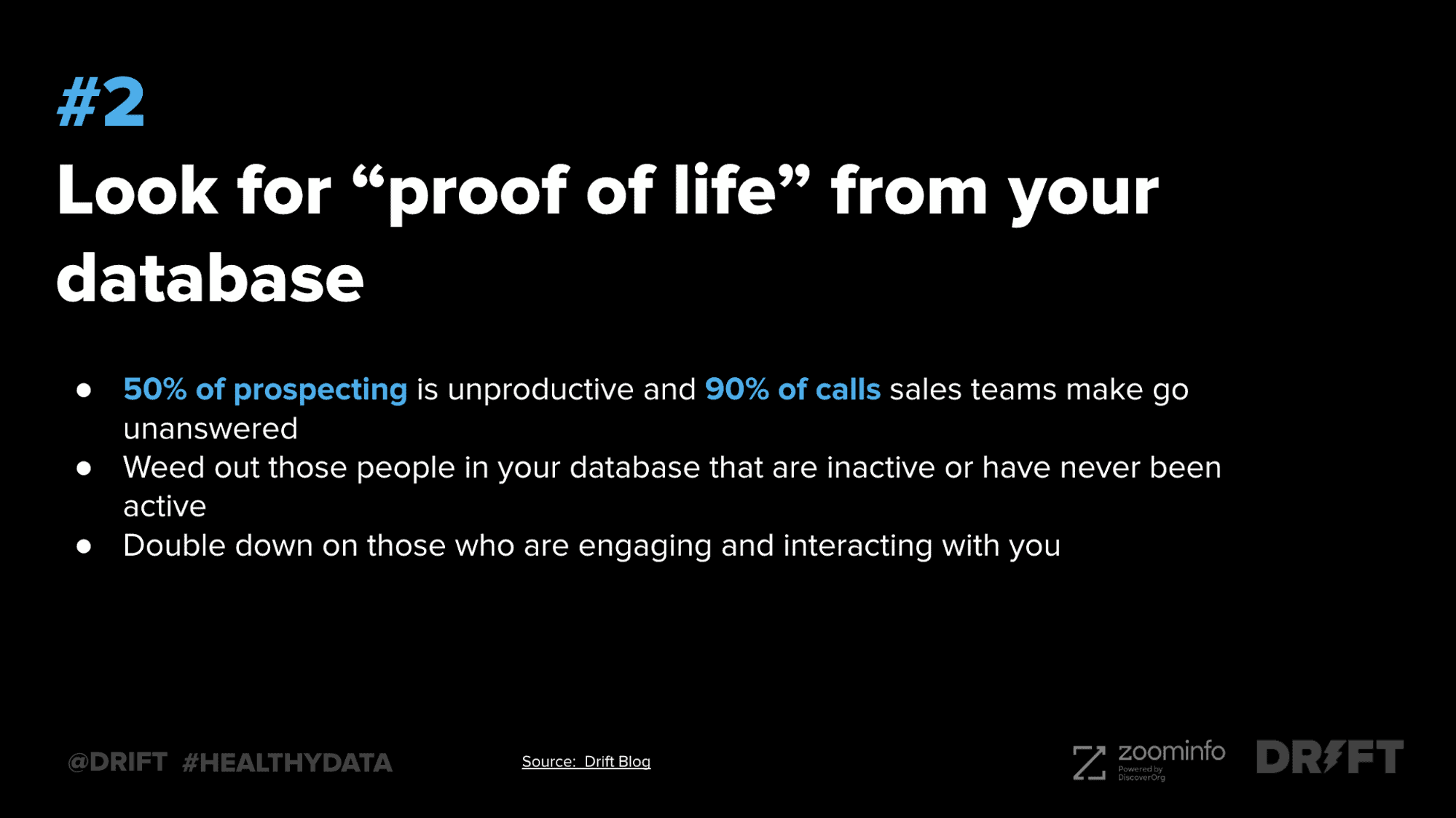
That said, your team should still have an end game for The Unknown contacts. Because let’s say you’ve tried all of the above ways of trying to engage with these emails for a month with no response. This may be when you decide it’s time to delete that contact rather than keep it stored in your database.
Is deleting a contact harsh? Absolutely not. At the point when The Unknown hasn’t interacted with your site or email content for an extended period of time, it now becomes a question of team time management. Continually reaching out to unknown contacts that haven’t shown any “proof of life” is counterproductive and drains resources you could be putting toward engaging more valuable customers.
The Unknown: Data-Driven Databases
Today’s consumer is much more aware of their data and what information companies have access to. People know you have data on them and expect personalized outreach. If it’s not hyper-personalized, your campaign message will not do well.
The data-driven approach gauntlet has been dropped and marketers need to run with it. Any time you have access to mounds of data, take advantage of it – and feed it back into any part of the process possible. This only helps to more quickly break down The Unknowns into Knowns.
Is there a shot at The Unknowns sliding up into The Good category? Maybe. But only if you do the work.
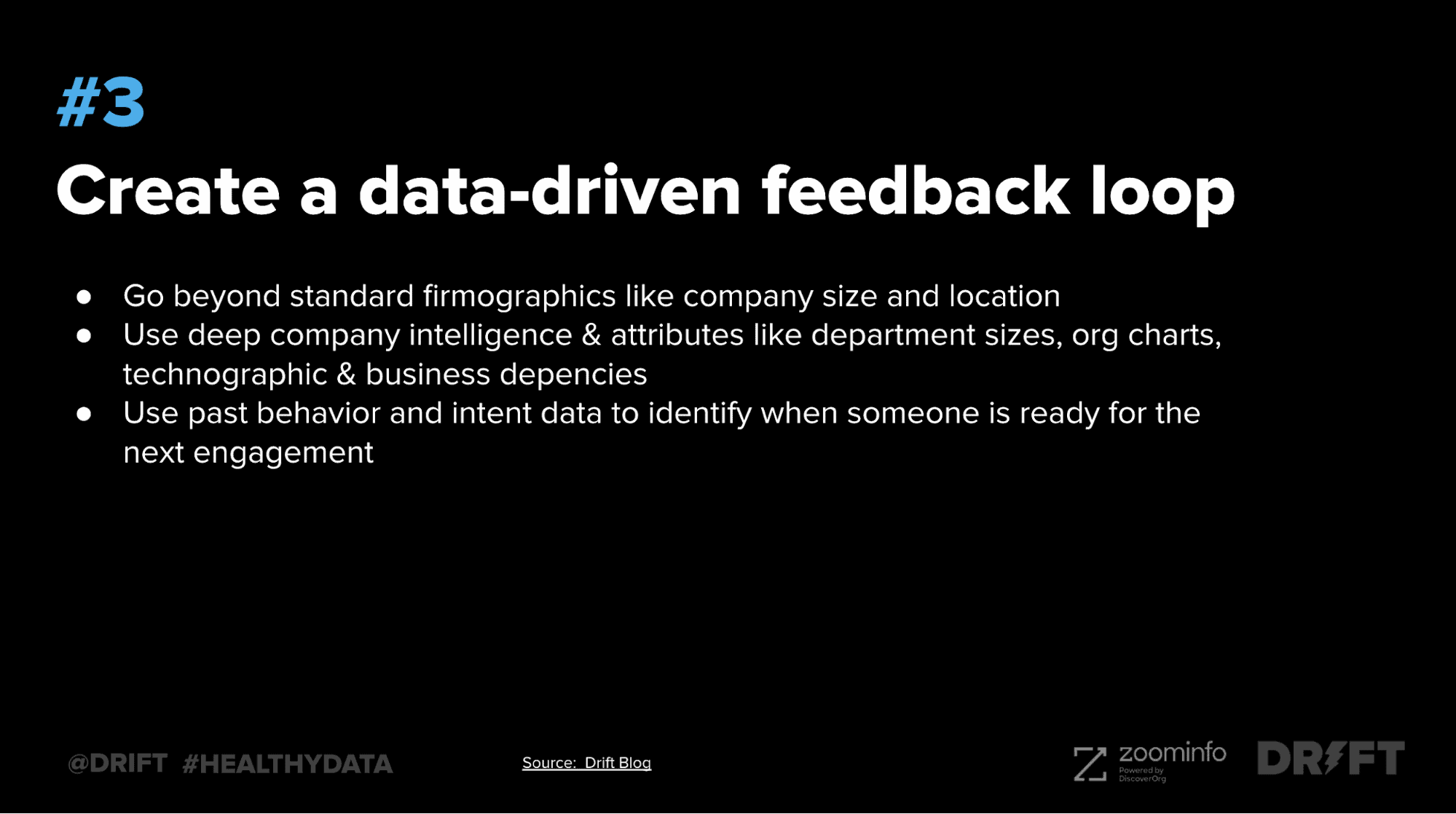
Gather all the information you’ve received from those initial filtering segments and feed it back into a more personalized approach. This data-driven approach will help boost your campaign’s chances of customer engagement and retention.
Why? Because well-maintained databases use all additional data points available to personalize messages.
Risky Business: A Reminder of What Happens When You Don’t Focus on Database Health
I’ve seen marketing departments range in the frequency of cleaning their databases. Some do it once a year. Some do it once a quarter. Some do it weekly.
The most important thing? Actually doing it.
So before I leave you, here’s a quick reminder why (and what’s at stake) ?
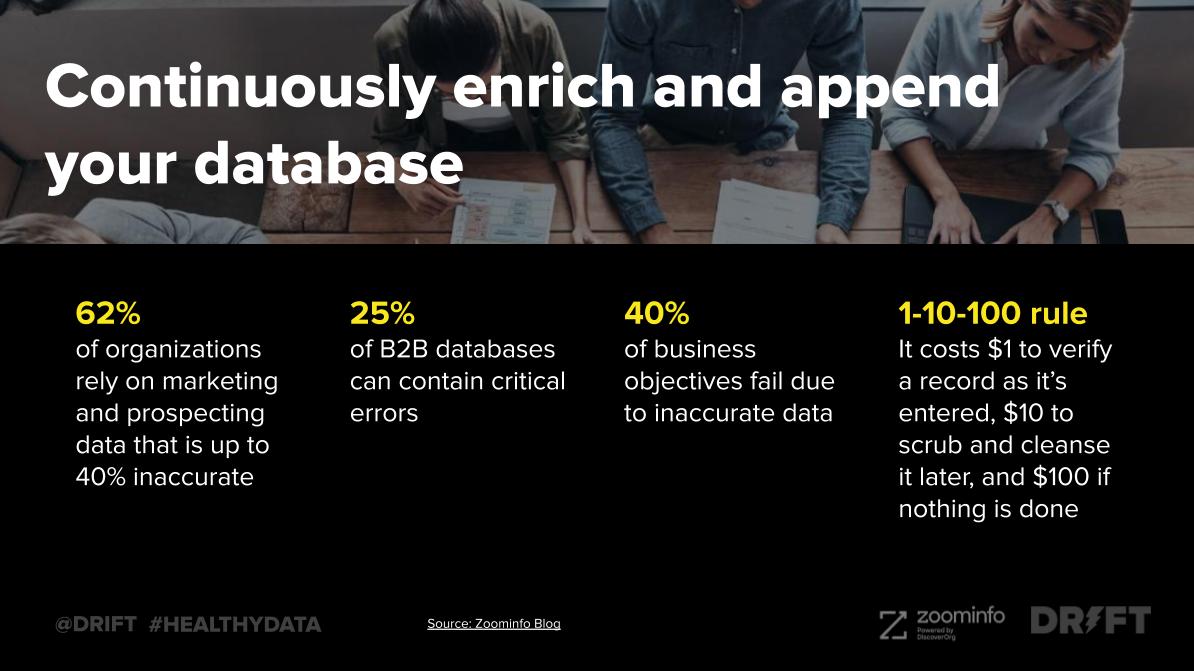
Nobody wants a labor-intensive day of email marketing database cleanup. It takes away valuable time that could be spent on improving business objectives, enhancing sales prospecting, and moving the company forward.
Each time new information and segments arise, it’s on you to update and refine your email marketing databases. That’s the key.
If your team routinely cleans and updates all of that incoming data, email marketing database hygiene won’t become this big laborious task everyone dreads. When done correctly, your team will not only thrive, but they’ll also move the needle for your company – in a big way.




